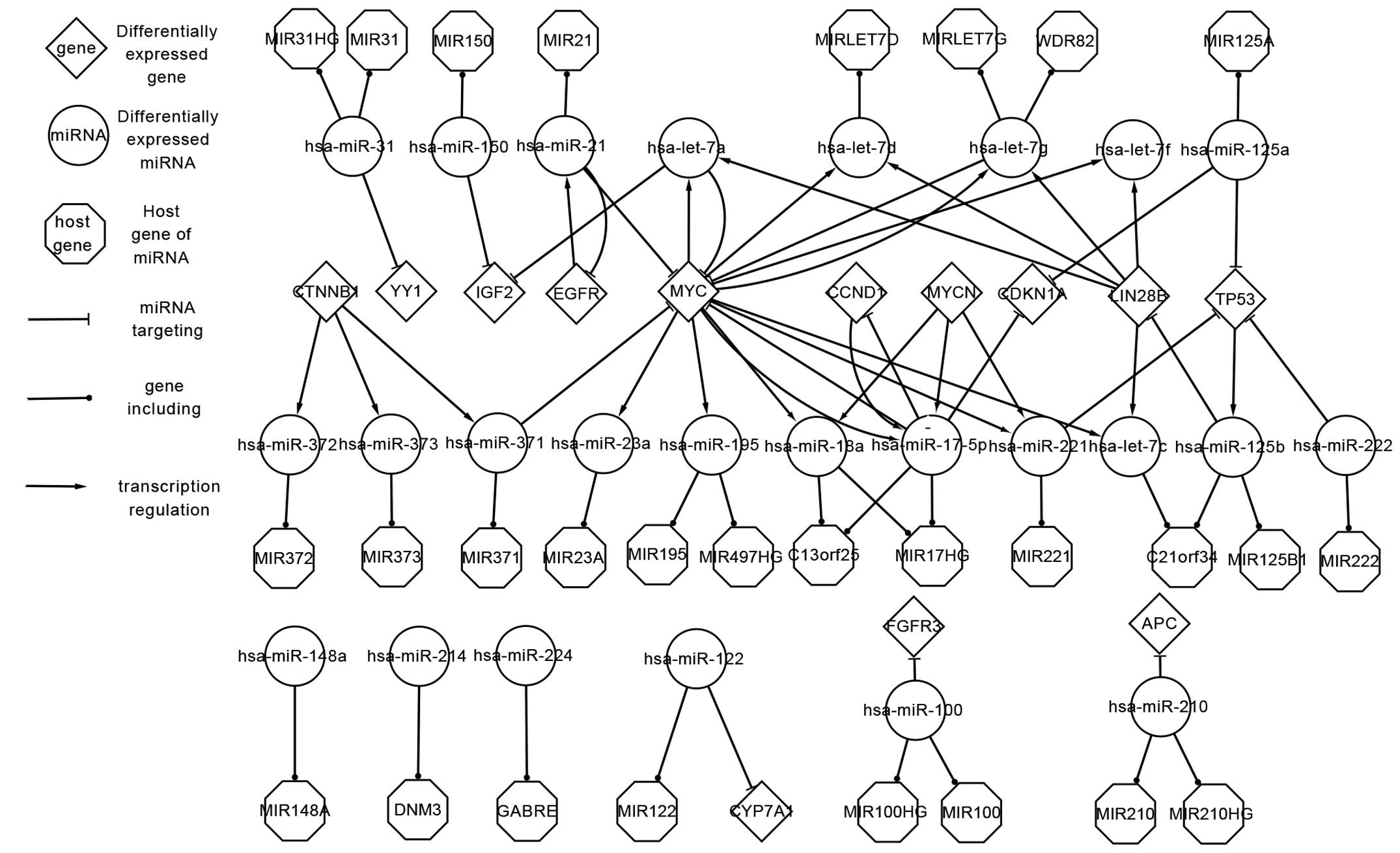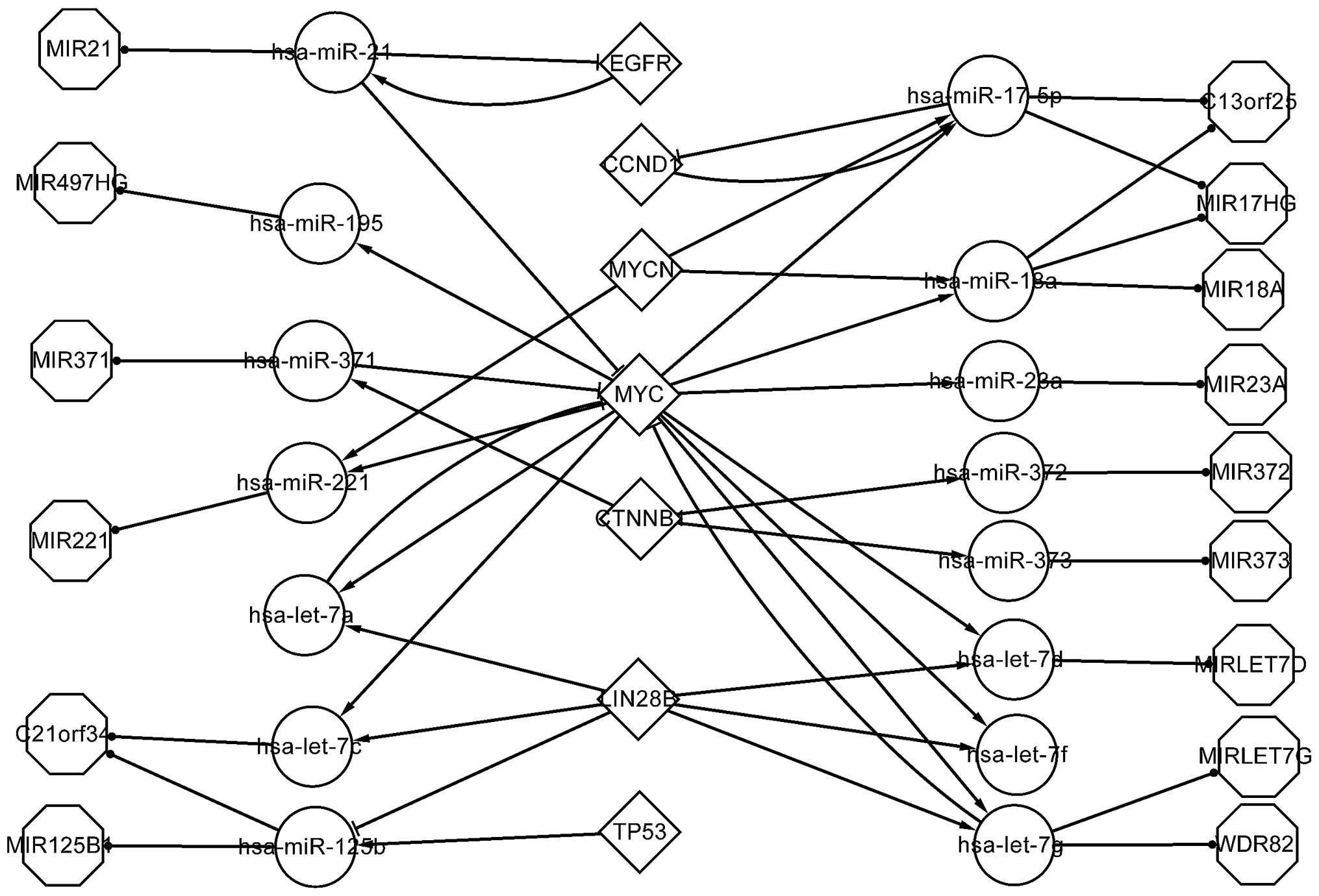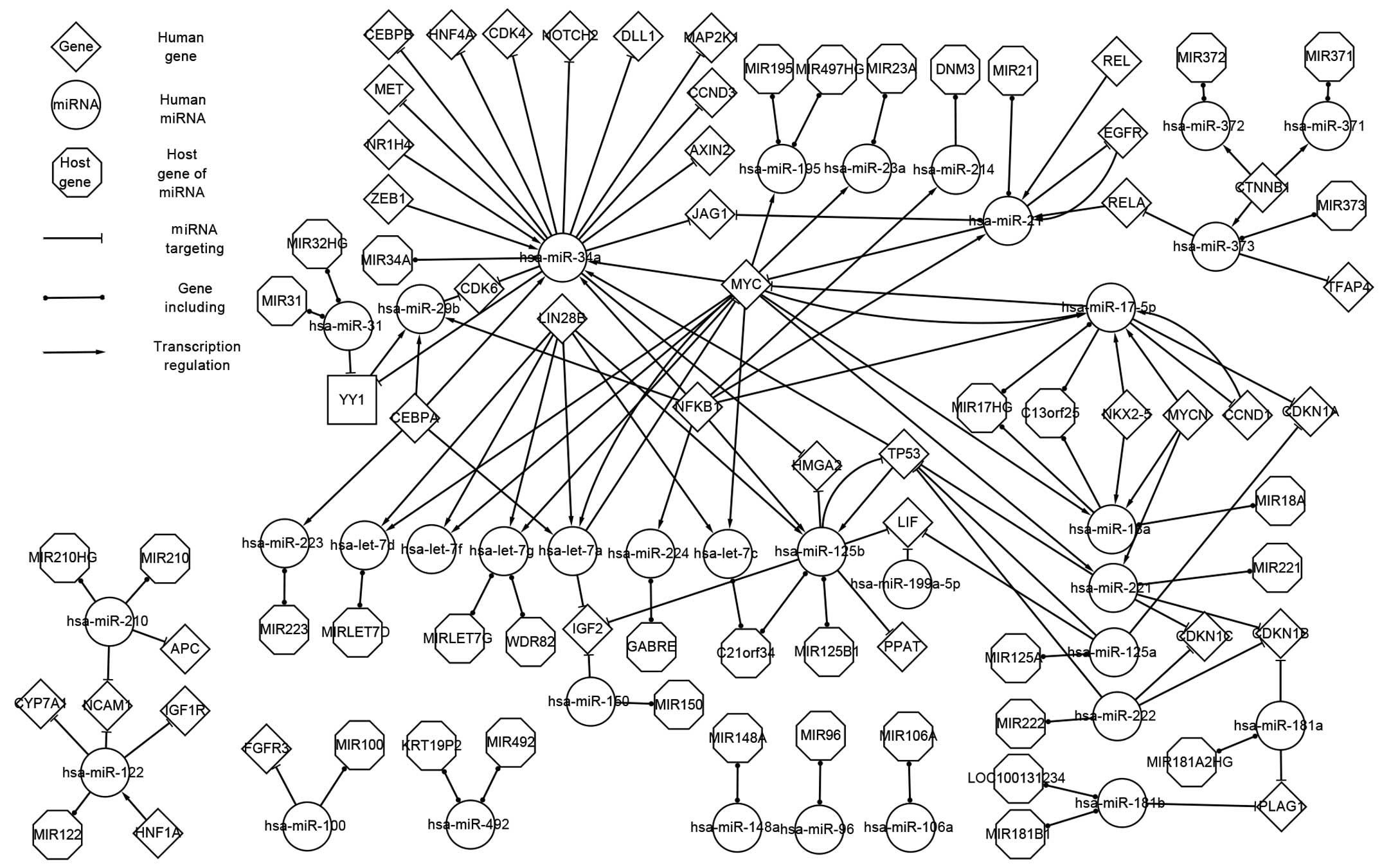|
1
|
De Ioris M, Brugieres L, Zimmermann A,
Keeling J, Brock P, Maibach R, Pritchard J, Shafford L, Zsiros J,
Czaudzerna P and Perilongo G: Hepatoblastoma with a low serum
alpha-fetoprotein level at diagnosis: The SIOPEL group experience.
Eur J Cancer. 44:545–550. 2008. View Article : Google Scholar : PubMed/NCBI
|
|
2
|
Lack EE, Neave C and Vawter GF:
Hepatoblastoma. A clinical and pathologic study of 54 cases. Am J
Surg Pathol. 6:693–705. 1982. View Article : Google Scholar : PubMed/NCBI
|
|
3
|
Herzog CE, Andrassy RJ and Eftekhari F:
Childhood cancers: Hepatoblastoma. Oncologist. 5:445–453. 2000.
View Article : Google Scholar : PubMed/NCBI
|
|
4
|
Shin E, Lee KB, Park SY, Kim SH, Ryu HS,
Park YN, Yu E and Jang JJ: Gene expression profiling of human
hepatoblastoma using archived formalin-fixed and paraffin-embedded
tissues. Virchows Arch. 458:453–465. 2011. View Article : Google Scholar : PubMed/NCBI
|
|
5
|
Baynam GS and Goldblatt J: A child with an
FGFR3 mutation, a laterality disorder and an hepatoblastoma: Novel
associations and possible gene-environment interactions. Twin Res
Hum Genet. 13:297–300. 2010. View Article : Google Scholar : PubMed/NCBI
|
|
6
|
Zimmermann A: The emerging family of
hepatoblastoma tumours: From ontogenesis to oncogenesis. Eur J
Cancer. 41:1503–1514. 2005. View Article : Google Scholar : PubMed/NCBI
|
|
7
|
Hobert O: Gene regulation by transcription
factors and microRNAs. Science. 319:1785–1786. 2008. View Article : Google Scholar : PubMed/NCBI
|
|
8
|
Latchman DS: Transcription factors: An
overview. Int J Biochem Cell Biol. 29:1305–1312. 1997. View Article : Google Scholar : PubMed/NCBI
|
|
9
|
Bartel DP: MicroRNAs: Target recognition
and regulatory functions. Cell. 136:215–233. 2009. View Article : Google Scholar : PubMed/NCBI
|
|
10
|
Magrelli A, Azzalin G, Salvatore M,
Viganotti M, Tosto F, Colombo T, Devito R, Di Masi A, Antoccia A,
Lorenzetti S, et al: Altered microRNA expression patterns in
hepatoblastoma patients. Transl Oncol. 2:157–163. 2009. View Article : Google Scholar : PubMed/NCBI
|
|
11
|
Hobert O: Common logic of transcription
factor and microRNA action. Trends Biochem Sci. 29:462–468. 2004.
View Article : Google Scholar : PubMed/NCBI
|
|
12
|
Wang J, Lu M, Qiu C and Cui Q: TransmiR: A
transcription factor-microRNA regulation database. Nucleic Acids
Res. 38:D119–D122. 2010. View Article : Google Scholar : PubMed/NCBI
|
|
13
|
Griffiths-Jones S, Grocock RJ, van Dongen
S, Bateman A and Enright AJ: miRBase: MicroRNA sequences, targets
and gene nomenclature. Nucleic Acids Res. 34:D140–D144. 2006.
View Article : Google Scholar : PubMed/NCBI
|
|
14
|
Naeem H, Küffner R and Zimmer R: MIRTFnet:
Analysis of miRNA regulated transcription factors. PLoS One.
6:e225192011. View Article : Google Scholar : PubMed/NCBI
|
|
15
|
Volinia S, Calin GA, Liu CG, Ambs S,
Cimmino A, Petrocca F, Visone R, Iorio M, Roldo C, Ferracin M, et
al: A microRNA expression signature of human solid tumors defines
cancer gene targets. Proc Natl Acad Sci USA. 103:2257–2261. 2006.
View Article : Google Scholar : PubMed/NCBI
|
|
16
|
Ishimoto K, Nakamura H, Tachibana K,
Yamasaki D, Ota A, Hirano K, Tanaka T, Hamakubo T, Sakai J, Kodama
T and Doi T: Sterol-mediated regulation of human lipin 1 gene
expression in hepatoblastoma cells. J Biol Chem. 284:22195–22205.
2009. View Article : Google Scholar : PubMed/NCBI
|
|
17
|
Brand AH and Perrimon N: Targeted gene
expression as a means of altering cell fates and generating
dominant phenotypes. Development. 118:401–415. 1993.PubMed/NCBI
|
|
18
|
Rodriguez A, Griffiths-Jones S, Ashurst JL
and Bradley A: Identification of mammalian microRNA host genes and
transcription units. Genome Res. 14:1902–1910. 2004. View Article : Google Scholar : PubMed/NCBI
|
|
19
|
Gennarino VA, Sardiello M, Avellino R,
Meola N, Maselli V, Anand S, Cutillo L, Ballabio A and Banfi S:
MicroRNA target prediction by expression analysis of host genes.
Genome Res. 19:481–490. 2009. View Article : Google Scholar : PubMed/NCBI
|
|
20
|
Papadopoulos GL, Reczko M, Simossis VA,
Sethupathy P and Hatzigeorgiou AG: The database of experimentally
supported targets: A functional update of TarBase. Nucleic Acids
Res. 37:D155–D158. 2009. View Article : Google Scholar : PubMed/NCBI
|
|
21
|
Kozomara A and Griffiths-Jones S: miRBase:
Integrating microRNA annotation and deep-sequencing data. Nucleic
Acids Res. 39:D152–D157. 2011. View Article : Google Scholar : PubMed/NCBI
|
|
22
|
Garfield E: “Science Citation Index” - A
new dimension in indexing. Science. 144:649–654. 1964. View Article : Google Scholar : PubMed/NCBI
|
|
23
|
Chekmenev DS, Haid C and Kel AE: P-Match:
Transcription factor binding site search by combining patterns and
weight matrices. Nucleic Acids Res. 33:(Web Server). W432–W437.
2005. View Article : Google Scholar : PubMed/NCBI
|
|
24
|
Fujita PA, Rhead B, Zweig AS, Hinrichs AS,
Karolchik D, Cline MS, Goldman M, Barber GP, Clawson H, Coelho A,
et al: The UCSC Genome Browser database: Update 2011. Nucleic Acids
Res. 39:D876–D882. 2011. View Article : Google Scholar : PubMed/NCBI
|
|
25
|
Bao J, Li D, Wang L, Wu J, Hu Y, Wang Z,
Chen Y, Cao X, Jiang C, Yan W and Xu C: MicroRNA-449 and
microRNA-34b/c function redundantly in murine testes by targeting
E2F transcription factor-retinoblastoma protein (E2F-pRb) pathway.
J Biol Chem. 287:21686–21698. 2012. View Article : Google Scholar : PubMed/NCBI
|
|
26
|
Jiang Q, Wang Y, Hao Y, Juan L, Teng M,
Zhang X, Li M, Wang G and Liu Y: miR2Disease: A manually curated
database for microRNA deregulation in human disease. Nucleic Acids
Res. 37:D98–104. 2009. View Article : Google Scholar : PubMed/NCBI
|
|
27
|
Golan D, Levy C, Friedman B and Shomron N:
Biased hosting of intronic microRNA genes. Bioinformatics.
26:992–995. 2010. View Article : Google Scholar : PubMed/NCBI
|
|
28
|
Cairo S, Wang Y, de Reyniès A, Duroure K,
Dahan J, Redon MJ, Fabre M, McClelland M, Wang XW, Croce CM and
Buendia MA: Stem cell-like micro-RNA signature driven by Myc in
aggressive liver cancer. Proc Natl Acad Sci USA. 107:20471–20476.
2010. View Article : Google Scholar : PubMed/NCBI
|
|
29
|
López-Terrada D, Gunaratne PH, Adesina AM,
Pulliam J, Hoang DM, Nguyen Y, Mistretta TA, Margolin J and
Finegold MJ: Histologic subtypes of hepatoblastoma are
characterized by differential canonical Wnt and Notch pathway
activation in DLK+ precursors. Hum Pathol. 40:783–794.
2009. View Article : Google Scholar : PubMed/NCBI
|
|
30
|
King CE, Wang L, Winograd R, Madison BB,
Mongroo PS, Johnstone CN and Rustgi AK: LIN28B fosters colon cancer
migration, invasion and transformation through let-7-dependent and
-independent mechanisms. Oncogene. 30:4185–4193. 2011. View Article : Google Scholar : PubMed/NCBI
|
|
31
|
Viswanathan SR and Daley GQ: Lin28: A
microRNA regulator with a macro role. Cell. 140:445–449. 2010.
View Article : Google Scholar : PubMed/NCBI
|
|
32
|
Giardiello FM, Petersen GM, Brensinger JD,
Luce MC, Cayouette MC, Bacon J, Booker SV and Hamilton SR:
Hepatoblastoma and APC gene mutation in familial adenomatous
polyposis. Gut. 39:867–9. 1996. View Article : Google Scholar : PubMed/NCBI
|
|
33
|
Zirn B, Hartmann O, Samans B, Krause M,
Wittmann S, Mertens F, Graf N, Eilers M and Gessler M: Expression
profiling of Wilms tumors reveals new candidate genes for different
clinical parameters. Int J Cancer. 118:1954–1962. 2006. View Article : Google Scholar : PubMed/NCBI
|
|
34
|
Li J, Xu ZW, Wang KH, Wang N, Li DQ and
Wang S: Networks of microRNAs and genes in retinoblastomas. Asian
Pac J Cancer Prev. 14:6631–6636. 2014. View Article : Google Scholar : PubMed/NCBI
|

















